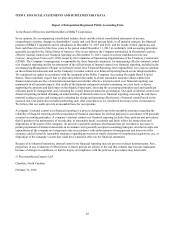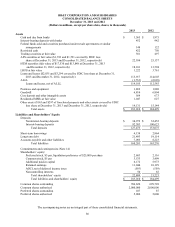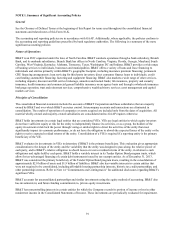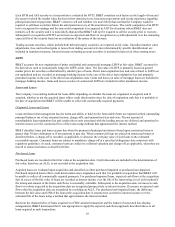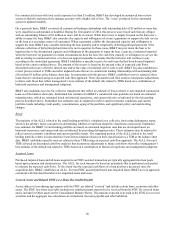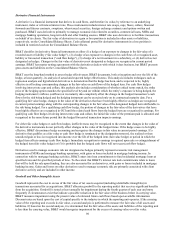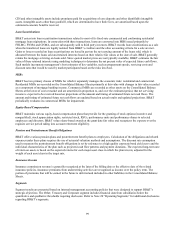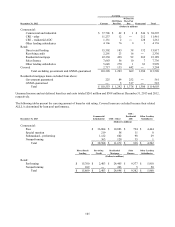BB&T 2013 Annual Report Download - page 95
Download and view the complete annual report
Please find page 95 of the 2013 BB&T annual report below. You can navigate through the pages in the report by either clicking on the pages listed below, or by using the keyword search tool below to find specific information within the annual report.
95
Assets acquired as a result of foreclosure are subsequently carried at the lower of cost or net realizable value. Net realizable
value equals fair value less estimated selling costs. Any excess of cost over net realizable value at the time of foreclosure is
charged to the ALLL. NPAs are subject to periodic revaluations of the collateral underlying impaired loans and foreclosed
real estate. The periodic revaluations are generally based on the appraised value of the property and may include additional
liquidity adjustments based upon the expected retention period. BB&T’s policies require that valuations be updated at least
annually and that upon foreclosure, the valuation must not be more than six months old, otherwise an updated appraisal is
required. Routine maintenance costs, other costs of ownership, subsequent declines in market value and net losses on disposal
are included in foreclosed property expense.
ACL
The ACL includes the ALLL and the RUFC. The ACL represents management’s best estimate of probable credit losses
inherent in the loan and lease portfolios and off-balance sheet lending commitments at the balance sheet date. The Company
determines the ACL based on an ongoing evaluation. This evaluation is inherently subjective because it requires material
estimates, including the amounts and timing of cash flows expected to be received on impaired loans. Those estimates are
susceptible to significant change. Changes to the ACL are made by charges to the provision for credit losses, which is
reflected in the Consolidated Statements of Income. Loans or lease balances deemed to be uncollectible are charged off
against the ALLL. Recoveries of amounts previously charged off are credited to the ALLL. The methodology used to
determine the RUFC is inherently similar to that used to determine the collectively evaluated component of the ALLL,
adjusted for factors specific to binding commitments, including the probability of funding and exposure at default. While
management uses the best information available to establish the ACL, future adjustments may be necessary if economic
conditions differ substantially from the assumptions used in computing the ACL or, if required by regulators, based upon
information available to them at the time of their examinations.
Accounting standards require the presentation of certain disclosure information at the portfolio segment level, which
represents the level at which an entity develops and documents a systematic methodology to determine its ACL. BB&T
concluded that its loan and lease portfolio consists of three portfolio segments; commercial, retail and covered. The
commercial portfolio segment includes CRE, commercial and industrial and other loans originated by certain other lending
subsidiaries, and was identified based on the risk-based approach used to estimate the ALLL for the vast majority of these
loans. The retail portfolio segment includes direct retail lending, revolving credit, residential mortgage, sales finance and
other loans originated by certain retail-oriented subsidiaries, and was identified based on the delinquency-based approach
used to estimate the ALLL. The covered portfolio segment was identified based on the expected cash flows approach used to
estimate the ALLL related to acquired loans subsequent to December 31, 2008.
A portion of the ALLL may not be allocated to any specific category of loans. Any unallocated portion of the ALLL reflects
management’s best estimate of the elements of imprecision and estimation risk inherent in the calculation of the overall
ALLL. During 2013, BB&T incorporated these elements into the ALLL determination for each loan category such that there
is not an unallocated ALLL as of December 31, 2013.
The entire amount of the ACL is available to absorb losses on any loan category or lending-related commitment.
The following provides a description of accounting policies and methodologies related to each of the portfolio segments:
Commercial
The vast majority of loans in the commercial lending portfolio are assigned risk ratings based on an assessment of conditions
that affect the borrower’s ability to meet contractual obligations under the loan agreement. This process includes reviewing
borrowers’ financial information, historical payment experience, credit documentation, public information, and other
information specific to each borrower. Risk ratings are reviewed on an annual basis for all credit relationships with total
credit exposure of $1 million or more, or at any point management becomes aware of information affecting the borrowers’
ability to fulfill their obligations.
Risk Rating Description
Pass Loans not considered to be problem credits
Special Mention Loans that have a potential weakness deserving management’s close attention
Substandard Loans for which a well-defined weakness has been identified that may put full collection of
contractual cash flows at risk


